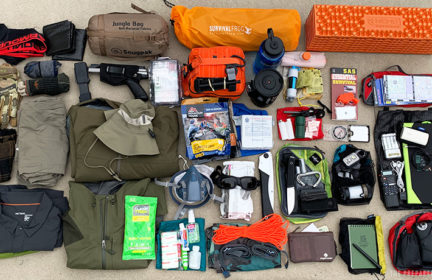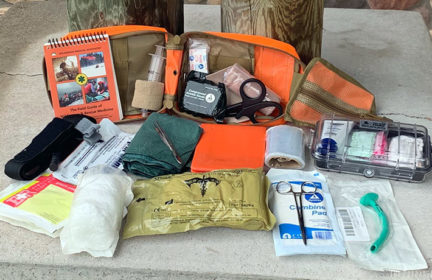Makeover of a pre-assembled BOB in 1 week and $125
Last weekend I pulled my husband’s BOB out from its storage spot and did an inventory. He bought it pre-assembled when we first started dating (and I said, “You have an earthquake kit, right?”) and I remember going through it at one point, but I had forgotten how long ago that was and how crummy the kit was to begin with. (I don’t know what I thought about who was maintaining it during this period of time.)
At first, I thought it would take a lot of time and money to rectify the situation, but then I found a ton of extras and replacements in the house, spent $125 on new stuff, and one week later, the bag is SO much better. It’s not “done”, but I’m really pleasantly surprised at what a difference I was able to make. I thought I’d share it with you all to celebrate this small prepping win, and also because it might prompt some interesting discussion about where these pre-assembled kits fall down.
On that point, I feel like the biggest gaps between what we got in the pre-assembled kit and my husband’s actual needs were in the following areas:
- IFAK. I give the kit maker credit for including a triangle bandage and safety pins in the FAK, but the rest of it was basically bandaids, and I don’t see the point of including trauma shears if you include none of the other materials one would need in the scenarios in which one needs shears. The “improved” kit still needs a lot of work, but my husband doesn’t have a lot of first aid knowledge, so I think training should be the priority for him here. In the meantime, I was able to improve the kit a lot by adding a lot of basic OTC medicines in small Ziplock bags that I already had on-hand, as well as useful things like oral rehydration solution.
- Toiletries. His had a lot of cheap stuff that he didn’t actually need and wouldn’t make him comfortable.
- Power/charging. It makes sense that the pre-assembled kits don’t include charging cords, since that has to be customized to one’s own electronics, but this was a major hole in the kit, and a power bank, wall plug, and charging cable set me back $40.
The “survive outdoors” stuff in the kit was also pretty bad, but given our particular circumstances, that doesn’t bother me too much: I’m against buying BOB duplicates of our better-quality backpacking and camping gear that we use regularly, so I’m fine with a cheap tube tent and mylar sleeping bag as lightweight, low-volume insurance in case we don’t have time to grab the better stuff on our way out the door.
The thing that bugs me most about his BOB right now is the quantity of cotton clothing, but we have some pretty good used outdoor gear stores here that I plan to hit for synthetic replacements and a fleece.
Here is a list of the CURRENT contents of his BOB, broken down by categories. Everything with an asterisk (*) is a new addition, (†) indicates new purchases. Aside from power, most of the $$$ were spent on a better food and water setup.
FOOD & WATER
- Lifestraw*
- 27 oz. Klean Kanteen, single-walled, filled*
- 30-pack Katadyn Micropur Purification Tablets*†
- 2 Coast Guard-style ration blocks*† (1 replaced from home supplies, 1 ordered)
- 5 tea bags of his favorite tea* (Note: I have a stove to heat the water.)
- 1 collapsible mug*†
SHELTER, WARMTH, & LIGHT
- plastic tube tent
- 1 mylar sleeping bag
- 2 single-use hand warmers (almost certain they are expired, but they’re light)
- 1 rechargeable headlamp
- 2 lighters* (had 1, added 1)
- an unknown, but volumetrically large quantity of very cheap cordage
- 1 “5-in-1” survival tool consisting of a whistle, a tiny compass, a tiny signal mirror, a very tiny and questionable “flint”, and a compartment for matches (came without matches)
- 12 stormproof matches*
- packet of dryer lint “tinder”*
CLOTHING
- 1 cotton t-shirt
- 1 pair jeans
- 1 pair long underwear bottoms*
- 1 warm hat
- 2 pair of socks* (had 1, added 1)
- 2 pair of boxers* (had 1, added 1)
- 1 old down jacket
- 1 old rain jacket
- 1 plastic poncho
- 1 bandana*
TOILETRIES
- 1 travel toothbrush
- 1 travel toothpaste
- 2 oz. Dr. Bronner’s*†
- 2 oz. hand sanitizer*
- 1 compact roll of toilet paper (i.e., no cardboard tube)*†
- 1 Paper Shower*
- 3 pair ear plugs*
- 1 eye cover*†
- 1 chapstick*
- 1 pair nail clippers*
INFORMATION & COMMUNICATION
- 1 walkie talkie and charging cord
- 1 very crappy hand-crank radio
- evacuation list* (things to grab in addition to the bag if we have a few minutes)
- photos of us together and with our dog*
- names, addresses, and phone numbers for various friends and relatives
- emergency information specific to our city
- the “critical information sheet” I made with all of our insurance policy numbers, claims department phone numbers, the dog’s vaccine info and microchip numbers, regular and emergency vet contact info, our most recent vaccines and doctor and dentist numbers, etc.
- detailed street maps for 3 West Coast cities
- small Rite in the Rain notebook*†
- pen, mechanical pencil, sharpie
TOOLS
- 1 off-brand Swiss Army Knife-style multitools (the big kind with a scissors)
- 1 credit card-size Fresnel lens*
IFAK
- 8 cleansing wipes
- 5 Q-tips, sterile
- 4 gauze pads (2 sizes)
- 1 pair trauma sheers
- 6 pair nitrile gloves* (kit came with 1 pair, which I put in an exterior pocket for ease of access; other 5 are in the kit)
- 1 CPR mask
- 1 triangle bandage
- 4 safety pins
- 1 pair tweezers
- 1 teeny tiny roll of medical tape
- 65 bandaids in varying sizes
- Coban roll*
- 3 packets oral rehydration solution*
- 20 Benadryl*
- 11 Acetaminophen*
- 6 Naproxen sodium*
- 20 Ibuprofen*
- 6 Loperamide*
- 5 mini-Ziplock bags for storing medications (dosage info written on these)*
POWER
- 1 Novoo Explorer power bank*†
- 1 USB wall plug*†
- 1 USB A to USB C charging cable*†
MISC.
- 1 KN95 mask*
- 1 cloth mask*
- 1 reusable half-face respirator*
- 1 packet of respirator filters*
- swim goggles*
- 1 deck of cards
- heavy gloves
- cash
- extra Ziplock and trash bags, varying sizes*
And here is what I removed from the pre-assembled kit:
- 12 packets of emergency drinking water, expired
- 2 Coast Guard-style ration blocks, expired
- 1 very flimsy “can opener” that looks far more likely to open one’s hand than one’s can
- 1 mylar sleeping bag
- 2 glow sticks
- 2 plastic ponchos
- 1 vinyl bag for toiletries, so stiff and sharp-edged that I nearly cut myself trying to open it
- 1 travel toothbrush
- 1 tiny hotel soap wrapped in paper
- 1 wash cloth
- 4 single-use shampoo packets (my husband shaves his head; it would take a long time for him to really need any shampoo, let alone three packets’ worth)
- 2 menstrual pads (my husband does not menstruate)
- 1 large plastic comb (as long as he has trauma shears, he won’t have hair long enough to need this 😀 )
- 1 disposable plastic razor
- 1 travel-size shaving gel
- 1 roll of toilet paper (like a giant normal one from the bathroom, with the cardboard inside)
- 1 off-brand Swiss Army Knife-style multitool (there were two)
- 4 cleansing wipes
- 5 cotton balls, packaged to be sterile
- approximately 2 million-minus-65 bandaids
-
Comments (18)
-

